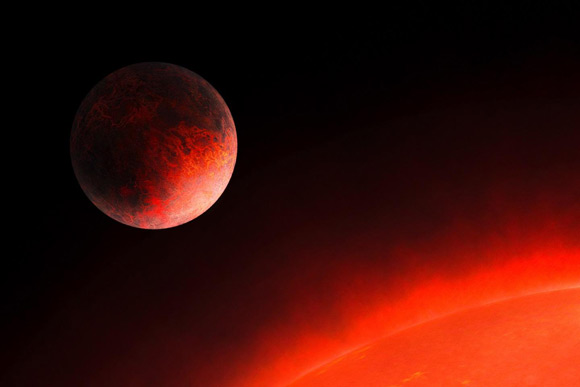Astronomers using NASA’s Transiting Exoplanet Survey Satellite (TESS) have identified a dense, ultra-short-period sub-Earth planet transiting the bright, nearby red dwarf Gliese 367.

An artist’s impression of the sub-Earth exoplanet Gliese 367b. Image credit: SPP 1992 (Patricia Klein).
Gliese 367 is located some 31 light-years away from Earth in the constellation of Vela.
Also known as GJ 367, CD-45 5378, HIC 47780, TIC 34068865 and TOI-731, this star is classified as an M-dwarf — a type of star that typically hosts multiple planets.
“For this class of star, the habitable zone would be somewhere between a two- to three-week orbit,” said Dr. George Ricker, an astronomer with the Kavli Institute for Astrophysics and Space Research at MIT.
“Since this star is so close by, and so bright, we have a good chance of seeing other planets in this system. It’s like there’s a sign saying, ‘Look here for extra planets!’”
The newfound planet, named Gliese 367b, has an orbital period of only 7.7 hours.
With a diameter of just over 9,000 km (5,592 miles), the alien world is slightly larger than Mars.
Gliese 367b is a rocky planet and likely contains a solid core of iron and nickel, similar to Mercury’s interior.
“We’re finding a Mars-sized planet that has the composition of Mercury,” said Dr. Roland Vanderspek, an astronomer in the Department of Physics and the Kavli Institute for Astrophysics and Space Research at MIT.
“It’s among the smallest planets detected to date, and it’s spinning around an M-dwarf on a very tight orbit.”
“The high density indicates the planet is dominated by an iron core,” said Dr. Szilárd Csizmadia, an astronomer with the Institute of Planetary Research at DLR (German Aerospace Center).
“These properties are similar to those of Mercury, with its disproportionately large iron and nickel core that differentiates it from other terrestrial bodies in the Solar System.”
Due to its extreme proximity to its star, Gliese 367b is blasted with 500 times more radiation than what the Earth receives from our Sun. As a result, its dayside boils at up to 1,500 degrees Celsius (2,732 degrees Fahrenheit).
Under such extreme temperatures, any substantial atmosphere would have long vaporized away, along with any signs of life, at least as we know it.
“We already know a few of ultra-short-period planets, but their origins are currently unknown,” said Dr. Kristine Lam, an astronomer with the Institute of Planetary Research at DLR (German Aerospace Center).
“By measuring the precise fundamental properties of the ultra-short-period planet, we can get a glimpse of the system’s formation and evolution history.”
“Understanding how these planets get so close to their host stars is a bit of a detective story,” said Dr. Natalia Guerrero, a member of the TESS science team.
“Why is this planet missing its outer atmosphere? How did it move close in? Was this process peaceful or violent? Hopefully this system will give us a little more insight.”
The discovery is reported in a paper in the journal Science.
_____
Kristine W.F. Lam et al. 2021. GJ 367b: A dense, ultrashort-period sub-Earth planet transiting a nearby red dwarf star. Science 374 (6572): 1271-1275; doi: 10.1126/science.aay3253







